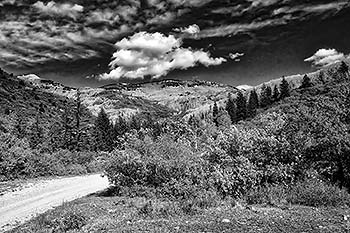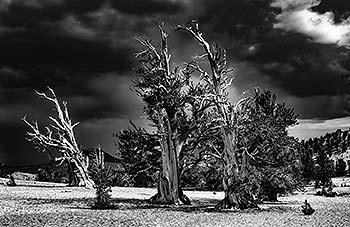 |
| This scene in the La Sal Mountains is featured in color in the 2022 Canyonlands calendar sold through visitor’s centers across southeast Utah. In black and white it takes on a different, dramatic look. |
There was a time when photography was a black-and-white medium, not the colorful one so familiar to us today. But monochorme images are by no means a thing of the past. Many photographers continue to make beautiful pictures in many shades of gray.
Some use the old ways, exposing film and making prints in a darkroom. You can even buy new Leica rangefinder cameras that capture only black-and-white digital images. But for the rest of us, there are many ways to achieve the results of a classic darkroom print using digital tools such as Photoshop.
The making of a truly artistic b&w image is not as easy as you might think. Consider that with color you have many more ways through which objects can stand out. When exposing b&w film in a camera, photographers often use filters to bring out details they want to emphasize. These include yellow, orange, green and red. The way these filters work is by blocking the light of certain colors. For example, a red filter blocks blue rays, making skies darker. A green filter helps separate leaves from their background.
In addition to this, fine art b&w photographers adjust the final print in the darkroom. They use techniques called dodging and burning to darken or lighten areas of the image, by giving more or less exposure to selected areas in the enlarger. Sometimes they use bleach to lighten subjects even more. Darkroom masters such as Ansel Adams sometimes spent several days learning exactly how to print a negative for dynamic impact.
 |
| A picture of ancient bristlecone pines was originally made on color film with a 4x5 inch view camera, then converted to a digital file. By tweaking contrast and opening shadows a dramatic b&w image was created. |
Today we can make similar prints using digital tools. You may be surprised to know that after you have converted a color picture to b&w in Photoshop, the image still retains the color data. That means that you can apply digital filters just as film photographers do. For example, apply a digital red filter and your skies will darken because the software recognizes the color data beneath that gray sky.
And it’s even better, because unlike the glass filters that had just one shade of intensity, you can adjust the depth of the digital filters using sliders to get just the result you want. There are also tools to help you dodge and burn, and you can even adjust exposure, contrast, and bring out shadow details with a few clicks of a mouse.
Not every scene makes a good subject for a b&w picture, but when done properly the results can be stunning. Removing color eliminates distractions from the desired effect. Monochrome images make us more aware of the shapes, lines, textures, and patterns that might get lost in a color picture.
Here are a couple of examples of b&w images I created with my computer. First is a picture made up in the La Sal mountains during autumn when the aspens turn yellow. It’s an interesting photograph in color, and in fact in a slightly different crop it’s the featured image for September in the 2022 Canyonlands calendars sold in National Park visitor’s centers around southeast Utah.
Converted to b&w and manipulated to bring out details and contrasts, it presents quite a different look. I wanted the dramatic cloud to stand out, and there is exquisite detail in the autumn foliage. The original picture was made with a Canon SLR camera.
The second example shows ancient bristlecone pines in California’s Inyo National Forest. The picture was made on color film using a 4x5 inch view camera. The transparency was drum scanned to create a digital file, then modified in the computer to bring out detail that is lost in the color version. I increased contrast and opened shadow areas to highlight details of the tree trunks, some of which are thousands of years old. A dramatic sky finishes the effect.
_____________________________________________
David L. Brown is a landscape photographer who has led photo tours from his base in Moab since 2015, now as Printworks Photo Tours. His fine art prints can be seen at Printworks Gallery, 1105 S. Hwy. 191. He invites you to visit or call at 435-355-0121.
|